By Gina Castro
When people decide to add a four-legged friend to their family, kittens and puppies are the first to come to mind. A young pet, a clean slate seems to be the ideal pet. Have you ever wondered about the not so perfect pets? Who adopts them? Handicapped pets are constantly overlooked because, well, some of them come with challenges. A pet with special needs requires more patience, love and sometimes additional financial resources. However, these pets have the biggest hearts. Their traumatic past makes them eager for your companionship and affection. Pensacola Magazine spoke to the owners of five very different special needs pets, and they all agreed caring for a handicapped pet is a rewarding experience.
Vinny Van Gogh
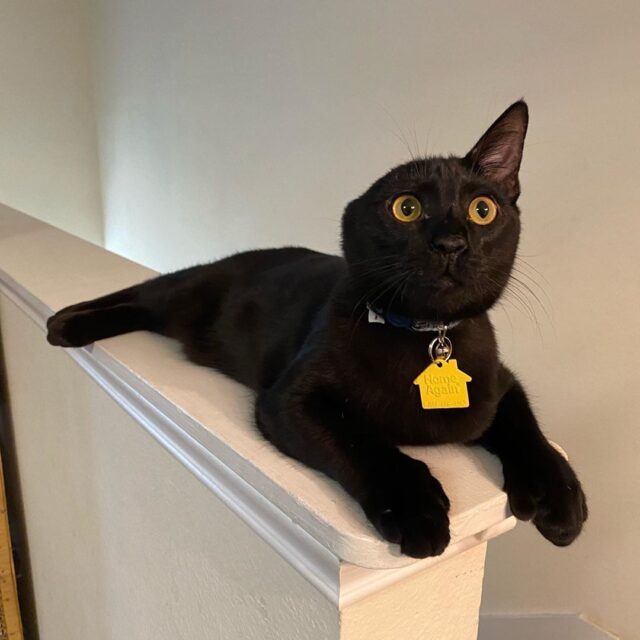
Weighing in at barely a pound, Vinny’s chances for survival seemed slim. Vinny’s ear was filled with maggots, so Coastal Sunrise Animal Hospital removed the ear and the ear canal down to the skull. The hospital did a second surgery shortly after to remove the lingering infection.
Despite it all, Vinny remained high spirited. Liz, a hospital employee, recalled Vinny’s personality just days after his major surgery. “He was super loving and super playful,” she said. “A day or two after his surgery, we put him in one of the exam rooms and played with a laser. If he weren’t missing an ear, you wouldn’t think there was something wrong with him.”
Even though Liz never considered owning a cat, she knew Vinny was special. “For him to go through that surgery and being attacked, he was still super loving,” Liz explained. “He let everyone here handle him. He was not ferocious or anything like that. I really admire that about him. I felt like he would make a perfect fit in my family and he did.”
So on New Year’s Eve 2019, Liz and her husband Colin added Vinny to their family. They named him after the Dutch painter who also lost an ear.
The hospital was concerned that Vinny would be deaf and have Horner’s Syndrome, which is when the head tilts or the eye droops down. Fortunately, Vinny didn’t suffer from any of those potential complications.
“He can still hear. It took him a little while at first,” Liz said. “He didn’t really know where sounds were coming from. He would look around all over. But he adapted very quickly.”
Today, Vinny leads a mostly normal life. We say “mostly normal” because many cats don’t have 59,000 fans on Instagram.
“He was so different. I’ve been doing this for almost four years, and I’ve never seen a cat with one ear. But there are tons of cats out there with one ear for all different types of reasons. I know he looks different, but he’s not different.”
To keep up with Vinny, follow him on Instagram @VanGogh.Cat.
Big Head Fred
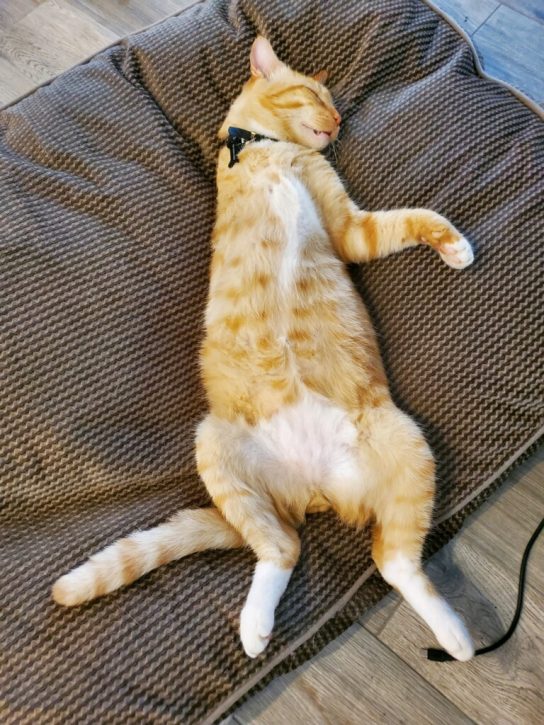
While scrolling through Facebook, Jesse Goodyear saw PHS’s photo of their newest pet, a three-legged cat. Theresa Goodyear, Jesse’s wife, remembered the first time she saw Fred.
“He [Jesse] showed him to me and said, ‘Look, he’s missing one arm.’ And I just immediately fell in love with him,” Theresa recalled. “I grew up with a special needs grandma who had both legs amputated. So I think that’s probably why I immediately wanted to keep him. He was really sweet to us right away. My husband picked him up and he just cuddled up with him. We knew we had to bring him home.”
The Goodyears adopted Fred during Christmas break in 2019. No one is really certain how Fred got shot, but he recovered from the situation.
Fortunately, Fred doesn’t require any medication or additional treatment for his disability, but that doesn’t mean having only three legs is easy. At first, Fred struggled with basic tasks like keeping balance while using the litter box and climbing the staircase. But just as he overcame losing a leg, he conquered those tasks, too.
“He can pretty much do anything,” Theresa said. “He can do everything other cats can do. He just figures out a different way to get it done.”
Aside from how he lost his leg, one of the first questions people ask upon meeting Fred is “Why is his name Big Head Fred?” PHS actually gave him that name while he was in recovery.
“The lady at the humane society said that whenever she would go check on Fred, he would just put his forehead on her head and purr,” Theresa explained. “He still does that. It’s so cute.”
Theresa described Fred as a cuddly, loving cat. “Whenever it’s bedtime, I’ll go put the kids down, read them a story and he’ll come in and cuddle with the kids while I do that,” Theresa said.
Inspired by Fred’s silly sleeping positions, Theresa started an Instagram account for him. You can follow him @BigHeadFredCat. If you’ve never considered adopting a handicapped pet, Theresa has some advice.
“Give them a chance,” she said. “I love him in a different kind of way because he beats the odds. He just shows me every day that anything is possible.”
Lydia
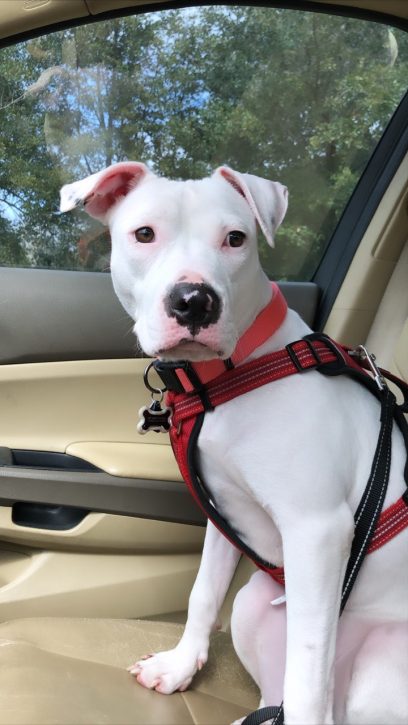
“When I was younger, we had a pit bull that was deaf. And a couple years ago, I had a Catahoula Cur that was deaf because her parents were overbred.”
Lydia, formerly known as Kim, became deaf at just five months old. Although the reason Lydia became deaf is unknown, Cherry suspects it was a result of a deep ear infection that damaged the nerves in her ear. Cherry adopted Lydia on October 29, 2019, just days after Cherry’s birthday.
Cherry’s prior experience with deaf dogs helped her discover the best ways to communicate with them as well as train them. She uses sign language to tell Lydia commands. For example, instead of verbally telling the dog to sit, Cherry uses her hands to sign the word “sit” to the dog.
“My previous dogs didn’t know any sign. They relied on vibration. So, I had to stomp on the floor to get their attention. Otherwise, they would get scared and bark or growl,” Cherry explained. “Learning from my previous pets has taught me to teach her commands at an early age. Getting it done earlier was easier for me because I got her when she was five months old.”
Other than being deaf, Lydia is just a typical pup. She’s a pitbull mix with almost limitless energy, and just like most puppies, she has a short attention span. Even though Lydia can’t hear sounds, it doesn’t stop her from making them.
“I wouldn’t call what she does barking. I would call it— She talks. It’s insane the noises that come out of her, but she barks sometimes when she feels threatened, “Cherry said. “Most of the time, she does these guttural noises that don’t really sound like anything an animal should make.”
Most dogs hear a guest’s knock. However, Lydia smells a guest’s scent. “If she’s asleep when people visit, she will smell them before she sees them,” Cherry said. “She’ll come sniffing around for them and then she gets all excited when she finds them.”
Although Cherry certainly has more experience owning a deaf dog than the average person does, she still had her challenges with Lydia. “Every time we would leave the room, she would cry and scratch at doors and even eat doors to get to us, so that was something that was definitely new and frustrating,” Cherry said.
Despite these challenges, Cherry believes adopting handicapped pets is a rewarding experience. “Not a lot of people want handicapped pets, but it’s really rewarding,” Cherry said. “If you’re interested in adopting an animal with a disability, just know that patience is a virtue and it’s going to take a long time to get them to where they need to be.”
Cadillac
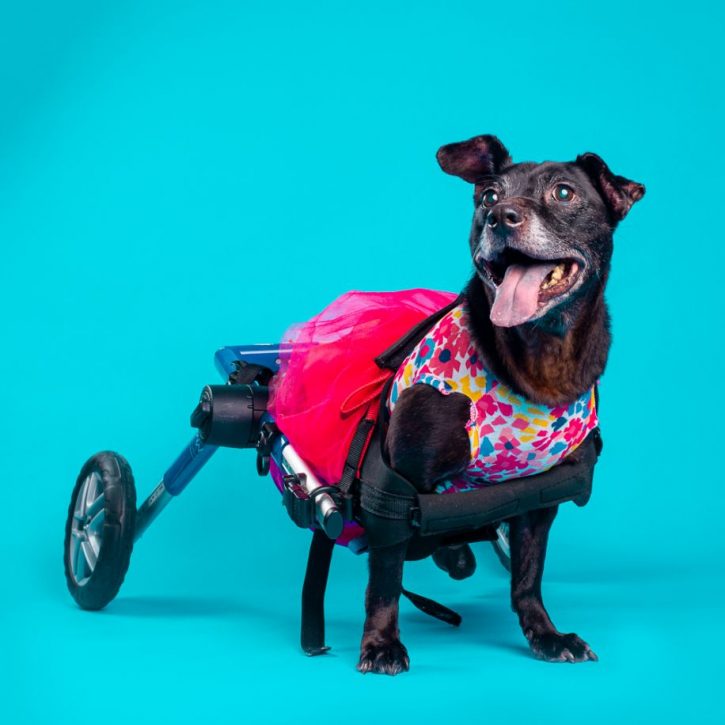
This attack caused Cadillac to lose use of her back legs, known as paraplegic. Some paraplegic dogs lose the ability to urinate and defecate on their own; however, she’s able to go to the bathroom without help more often than not.
“The clinic is very into giving animals a chance even if the animals don’t have a home,” Elysha Dawson, clinic technician, said.
Some doctors from the clinic adopted Cadillac from the animal shelter and raised her inside the clinic. All of the staff adores her. “She basically is the clinic’s dog,” Dawson said. “We all just care for her up here. She has all of us taking care of her.”
The clinic staff tried to improve Cadillac’s condition by doing physical therapy, hydrotherapy and even acupuncture to no avail. One of the staff members, however, did improve Cadillac’s quality of life by making her a wheelchair. Dawson said the staff member used PVC pipe and parts from a Cadillac to make the chair, which inspired her name. The clinic did a DNA test on Cadillac and found that she is a mix of Jack Russel and other breeds.
Cadillac has quite the bachelorette pad at the clinic, too. She has a gigantic crate and bed in her own space at the clinic.
Now Cadillac is around 14 years old, and she’s had several wheelchairs since. Dawson, who is now her legal owner, calls Cadillac the “clinic queen.” Cadillac is known to wear a few tutus or two, and don’t underestimate her. She can run circles around you in her chair.
“She’s the typical happy dog. When people see her, they think ‘aw poor dog,’ but honestly, she hasn’t had the use of her back legs since she was a tiny puppy,” Dawson said. “She doesn’t know any different.”
To learn more about Safe Harbor Animal Hospital, visit www.safeharboranimal.com.
Stimpy
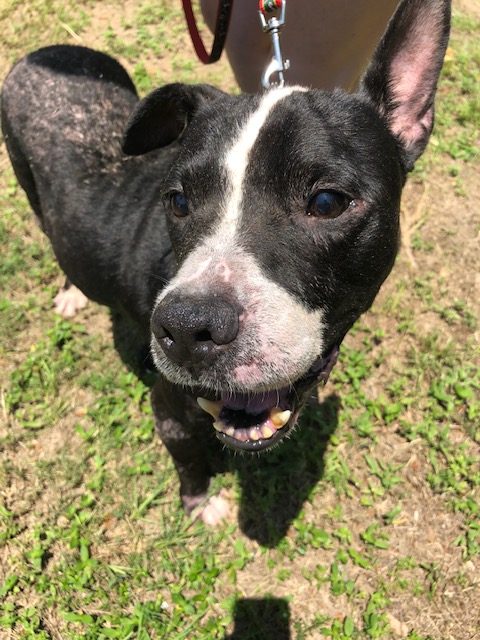
Because of prolonged neglect, Stimpy has become blind and mostly deaf. He also has demedex mange, which is an infestation of mites on the skin, arthritis, heartworms, a history of seizures and dental problems.
The humane society picked Stimpy up from the Santa Rosa Animal Hospital so that his condition could be treated, and he could have a second chance at life.
“We try to go over there and take animals under our care so that the hospital doesn’t have to make any difficult decisions about who is going to remain in the shelter and who is going to be euthanized,” Darra Flanagan, Director of Community Initiatives at Pensacola Humane Society, said. We try to help them out as much as possible.”
Flanagan explained that the PHS’s volunteer foster program gives them the ability to help more animals in both Escambia and Santa Rosa counties. Right now, Stimpy is being cared for through what PHS calls “Fospice,” which is a combination of foster and hospice.
“He has had such a hard life. He’s going to need medical care for the rest of his life. We will take care of his medical needs for the rest of his life until he passes,” Flanagan said. “That’s why we’re looking for a big–hearted angel to take him into their home to live his golden years.”
Even though Stimpy is on a plethora of medications to treat his condition, his loveable personality couldn’t be more apparent. “He just went from person to person to person in the office asking for them to love him,” Flanagan said. “I hardly did any work yesterday because I was busy loving him. All he wants is attention, passion, love and cuddles. He is just so loving.”
Since Stimpy is blind and going deaf, it’s important to always let him know where you are so that you don’t spook him. Flanagan explained that making noise or causing vibrations gets his attention.
“I know he sounds challenging, but it’s worth it,” Flanagan said. “He is just the most wonderful dog. It’s just one of the most beautiful dogs that I have ever met.”
If you are interested in fostering or adopting a pet, visit pensacolahumane.org/foster.